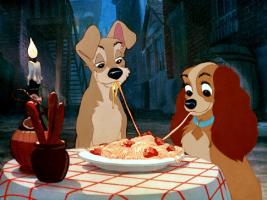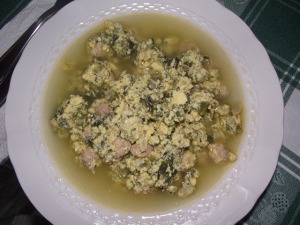Ciao a Tutti,
today’s post we’ll be more than simply interesting because I chose to finally talk about Spaghetti with Meatballs, the most not-Italian, iconic, stereotyped, and famous Italian-American dish.
My first experience with it was when I was very little, I was watching a

beautiful Disney movie, called The Lady and The Tramp, and as many of you will remember there there is the romantic kiss scene thanks to a “spaghetto” (with meatballs). Now, at first I remember I was amused and as a kid, a little moved but then – after the third/forth times – I focus my attention on that plate and I realized that I had never seen such a sauce for pasta. But I said it was a movie so “not real” because why should they put those big balls in the plate when you’re still eating pasta?! – unlikely, few years later, I realized that that was a proper way to do it in a far away land, called USA.
Now, I want to answer this question once and for all. In Italy, meatballs are called “polpette” and they are, of course, cooked with tomato sauce but not served with pasta. Because it is a second course, so it comes after you finish eating the first dish which is pasta with the same sauce you used to cook the polpette. Every type of meat you cook with the tomato sauce is served after the pasta, not with it. It is true that you might used the same plate in which you ate pasta but still … no, you can’t eat it together! Also, my region is one of those where polpette are made in many different ways – I’m an expert about it even if I’m vegetarian! So, it’s fair enough to eat tiny small polpette with pasta with tomato sauce just when those meatballs are as I said tiny and small! It’s

a variation of the “ragù alla Bolognese” (the label “Bolognese sauce” doen’t exist, but I will talk about it in another post) where little pieces of meat are cooked together
with the tomato sauce. Or, again, on Christmas day in my region is very common to prepare “Brodo di Natale” which has cardoon, endive, stracciatella (similar to egg drop soup), and finally little meatballs. That’s it! All you have to know about Italian meatballs that it is also confirmed by Corby Kummer:
What happened in the States is always a matter of convenience (and laziness I suppose) because of the habit of putting everything in the same plate, with no particular order for first, second, side or other courses. But to go deeper, I wanted to find something more than that and I find myself shocked to acknowledge that Spaghetti and Meatballs has its own English Wikipedia page where I read that
So, now, my fella Americans I will end my post with a link to the best (online) recipe for real meatballs – it’s in Italian but there are lots of

images to help you through the process and some online dictionaries will do the rest!
Try it and let me know! But do not serve it with pasta or as a very weird hotdog, please!
Ciao Ciao!


I really wanted to read this post because of its title! I wanted to understand what Italians thought of Spaghetti with meatballs. I like that you start your post in Italian! It adds a nice flare. I like the lady and the tramp reference; it connects the two cultures of Italian and American in a photo. I also was really interested in your explanation of Bolognese sauce and how we, Americans, like to “put everything in the same plate.” That made me laugh. I also like the way you ended the post to a link of a proper online recipe for meatballs! I can’t wait to check it out!
LikeLike
I’m hungry just reading this! I find it really funny how you used the lady and the tramp kissing scene to discuss spaghetti and meatballs. While most people focused on the kiss, you were looking at the meatballs on the plate. I cracked up how you called spaghetti and meatball in the U.S a “matter of convenience and laziness.” So true. I really miss authentic Italian food. I was in Italy for 2 weeks a few summers back and food hasn’t been the same since.
LikeLike
As an American I can attest to the fact that we like to put everything on one plate. Though I know this to be true for other cultures as well. I for one love to mix my foods, no matter what meal of the day. I definitely got some strange looks for doing so when I was in Holland. Perhaps there really are invisible boundaries in world cuisine. Either way, it is cool to get the inside scoop on pasta from an Italian who knows cooking (is that a majority then?). You should give the Meatball Hoagie a shot, it’s pretty good. Just know it is American while you’re eating it.
LikeLike
Great post. I think American’s have gotten to the point where we almost automatically assume that the “Italian” food we are eating is distinctly American. We can’t trust ourselves to be true to another culture. I think it’s interesting, too, to note that spaghetti and meatballs are now considered an American “comfort food” which we always go back to when we want something easy and simple. Pizza is another pseudo-Italian food we love to eat as comfort food.
LikeLike
Well, to be completely honest I am another stupid American that thinks Italians eat a lot of spaghetti and meatballs! It is really interesting to hear your perspective on such a quintessential american movie, especially when the key scene is a truly American stereotype. I’ve always associated spaghetti with meatballs, but the fact that they’re not supposed to be eaten together is completely mind-blowing. I’ve read a few of your other posts and I have definitely had my eyes open to the intricacies of Italian cuisine, it is all very confusing to me!
LikeLike
I really love your post! It is pretty funny to think about how much Americans attribute “spaghetti and meatballs” to Italy! Reflecting back on my trip to Italy a few years ago, I can remember that the meatballs were served separately! I never thought about it much then but it makes a lot more sense now! You are 100% correct…. Americans do have a habit of putting everything on the same plate! I am very guilty of this… especially when I am in the Caf because I never know what I want to eat! Thank you so much for sharing!!
LikeLike
Riccardo, I loved reading this post and how much Americans are doing it wrong! It is actually humurous to see how wrong we do Italian food. I mean, I am not one ounce Italian but I love Italian food more than anyone, or I guess I should say I love Italian-American food as much as anyone. The fact that meatballs are served on top of pasta here in the States but not in Italy is absolutely mind blowing. I’ve literally been served pasta with meatballs by people straight from Italy. It is just crazy to think that they serve it one way here in the States and completely another way in Italy.
LikeLike
I loved this post! I honestly assumed spaghetti and meatballs was an Italian dish that is really popular in the US, but I guess I am wrong! I totally agree that we are lazy and like to put everything on the plate at once instead of different courses. I think this takes away from the culture and experience of sitting down for meals with family or friends. From now on I will try to have my family eat this meal properly!
LikeLike